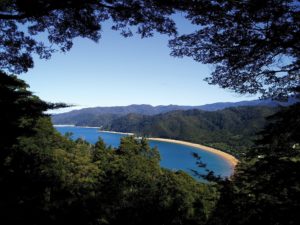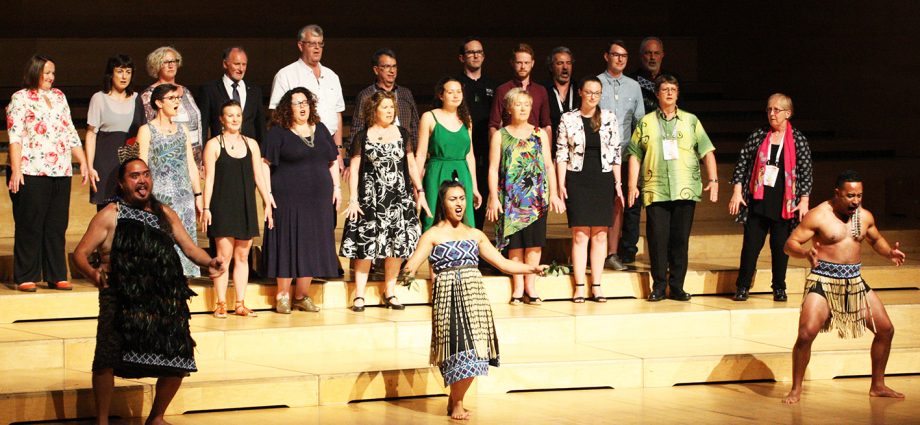Robert Wīremu, Conductor & Pedagogue, Auckland, New Zealand
In 2020, I was hoping to have welcomed you to the World Choral Symposium in Auckland, New Zealand where I was planning to present to you some ideas I’ve been considering – about sound, about space. The symposium was a highly anticipated occurrence that had never been hosted in the South Pacific before, and honestly a lot of delegates were drawn by – what we call – the “Lord of the Rings” factor. Unfortunately, “something” happened that forced its cancellation… Covid! The world went on a long siesta, singers were at a loss and singing was suddenly deemed dangerous. Cancelling the symposium was a heart-breaking decision, and these ideas of mine were put on hold… until now.

My talk would have been called “From the waha to the waharoa” – “From the mouth to the gate”. It’s a reference to the phenomenon of the kaikāranga, the extraordinary callers whose voices “pierce” the divide between our world and that of our ancestors so that the protocols of the welcome ritual can be observed to be followed correctly. You would have witnessed these extraordinary sounds upon your arrival at the symposium. My choice to use the word “pierce” is not accidental. My hope is that “pierce” evokes an impression of the amazing sounds these people are capable of – how else do you invite the dead to witness the ceremony? Now, imagine what a sound like that would do to a venue like St Paul’s, London or San Marco, Venezia or Sagrada Familia, Barcelona?
That’s the cultural reference.
The musical reference of “From the waha to the waharoa” is less romantic, based on a series of provocations and some broad and blatant generalisations, none of which I feel it necessary to apologise for. In an article of this length, details and rationalisations are a luxury, so generalisms abound.
Here goes…
If we assume that the basis for Western (European) choral music, the canon at the core of much of our musical activity, was designed for cathedrals, churches, and somewhat for stately houses, then perhaps we can also agree that – like the buildings – the sound aesthetic is tall, and contained, relying on reflective hard surfaces, in often cold climates. (I warned you about broad generalisations). Hard walls, tall spaces, cold climates clearly enable a particular sound. We know that sound. We often aim for that sound, whether we have the matching venues or not.
If we also assume that “choral” music aesthetics of other cultures, which were made for outdoor presentation in imperial courtyards, forecourts, and gardens, which often lack reflective walls, and are in warmer climates, that the sound is wider, less tall, warmer, and that the harmonic profile favours more reinforcement of the fundamental, then our imagination should easily conceive this. We know this sound in the Pacific, and in Asia, and in Africa, and in the Americas, even in Europe.
What do I mean when I describe sound as wide? I mean that the sound profile favours twang rather than head voice. I don’t mean folksy because that sends us in another direction completely. I’m referring to classical musics.
An interesting phenomenon has been unveiling in New Zealand over the past two decades, which has parallels in other parts of the world: these two things are coming together – outdoor sound with indoor choir! Under the bold and radical leadership of two of our leading choral conductors, Dr Karen Grylls and Elise Bradley, traditional Māori music is becoming an everyday aspect of our choral vernacular. Lead mostly by Grylls’ work with the NZ Youth Choir, the inclusion of authentic Māori music has completely changed the perspective of our choirs internationally. It’s almost expected – required – for touring NZ choirs to include Māori (and Pacific) music in their programmes. Audiences are somewhat disappointed when this doesn’t happen.
In earlier generations, composers “choralised” Māori songs – essentially using the source material of one culture and embedding it into the sound aesthetic of the other – the music was ‘walking to meet the choir’. Through Grylls and Bradley (in association with Wehi[1], Cassidy-Nanai, Munro, Kaa, Cooper, Hoffmann, and Tata), the choir ‘walked to meet the music’. Paradigm flipped!
What do I mean by this? The music was learnt and presented authentically. Cassidy-Nanai[2] trained the singers to haka[3] and pukana[4], to poi[5] and parry[6], and to sing with a sound aesthetic based on her modelling and her preferences: wider, and more of the fundamental, less use of head voice, as she had been taught.
If I can explain the problem from the opposite perspective: when choirs have occasion to sing on the ātea (the forecourt of the marae is a place for rhetoric, the domain of the God of War), the sound is often described as pretty but very quiet, and ghostlike – quite disembodied. The head-voice colour is lost in the open, without the assistance of tall, narrow spaces and hard, reflective surfaces. The problem for the NZ Youth Choir (the flipside of this paradigm) was that the wide, outside-ness, fundamental-oriented Māori sound often clashed with the containment of the tall, narrow venues where they often performed (on tours of the northern hemisphere: the cathedrals, the churches, the stately houses). Haka and kāranga qs et al, in ‘walking the choir all the way to the music’ perhaps we ‘took a few steps sideways’, resulting in a new aesthetic, a hybrid – with the genetic imprint of both parent artforms, yet an adolescent still, seeking its independence in a safe, new space in which to assert its own identity: someverticality, some use of head voice, a negotiation.
Do your choirs engage with indigenous music?
When your choirs engage with indigenous music, what do you do to maintain cultural integrity, authenticity? Do you ‘walk to where the music is’, or are you passive in your engagement? Did you also ‘take sideways steps’?
Is it possible to go so far towards the music that we lose track of our own choral identity? Probably. But how do we find the middle ground unless we step out and test boundaries? Do we risk working directly against the acoustic of the space for the sake of the music? Sure, let the room work for you, until it works against you. What price do we pay for either?
In terms of sound, how do you manage a space when the repertoire has such varied requirements? A Bach chorale has different needs to a Wehi haka. Obviously?
Are versatile venues the answer? No, I don’t think so. Versatile venues are good at everything by not being excellent at anything. We seek excellence, don’t we? (Apologies for offending acoustical engineers everywhere!)
Likewise, are half-measures good enough for choirs, or does that too risk authenticity?
I was so looking forward to sharing these ideas with you in Auckland, and the ensuing conversations afterwards. I was especially looking forward to the conversations afterwards because I know that many of these issues have already been considered by my colleagues globally. Your solutions would have been fascinating. We certainly haven’t found all the answers…
Yet!
 Robert Wīremu (Ngāti Kahungunu, Ngāti Porou, Ngāti Tūwharetoa) has become an established classical singing advocate in Aotearoa – teaching, coaching, arranging, conducting, collaborating and composing. He serves in governance roles (including the Kiri Te Kanawa Foundation, Auckland Chamber Choir Trust, and SOUNZ Music Centre), in advisory capacities (New Zealand Opera, Choirs Aotearoa New Zealand, and the new NZ Children’s Choral Academy) and as a professional teaching fellow at the School of Music, The University of Auckland. He is a former director for the NZ Secondary Students Choir, and Opera in the Pā, deputy director of the NZ National Singing School, and the NZ Youth Choir, and vocal coach of the national chamber choir, Voices NZ. Recently, his music has been featured by Voices New Zealand Chamber Choir, New Zealand Youth Choir, Auckland Opera Studio, Auckland Chamber Choir and Indian Ink Theatre. Robert’s arrangements of waiata have appeared at the Leeds Lieder Festival, Opera in the Pā, Auckland Arts Festival, the renaming of the Kiri Te Kanawa Theatre, and the Whānau concert at the Royal Albert Hall, and at St Paul’s Cathedral, Wellington, for the State Memorial for Queen Elizabeth II.
Robert Wīremu (Ngāti Kahungunu, Ngāti Porou, Ngāti Tūwharetoa) has become an established classical singing advocate in Aotearoa – teaching, coaching, arranging, conducting, collaborating and composing. He serves in governance roles (including the Kiri Te Kanawa Foundation, Auckland Chamber Choir Trust, and SOUNZ Music Centre), in advisory capacities (New Zealand Opera, Choirs Aotearoa New Zealand, and the new NZ Children’s Choral Academy) and as a professional teaching fellow at the School of Music, The University of Auckland. He is a former director for the NZ Secondary Students Choir, and Opera in the Pā, deputy director of the NZ National Singing School, and the NZ Youth Choir, and vocal coach of the national chamber choir, Voices NZ. Recently, his music has been featured by Voices New Zealand Chamber Choir, New Zealand Youth Choir, Auckland Opera Studio, Auckland Chamber Choir and Indian Ink Theatre. Robert’s arrangements of waiata have appeared at the Leeds Lieder Festival, Opera in the Pā, Auckland Arts Festival, the renaming of the Kiri Te Kanawa Theatre, and the Whānau concert at the Royal Albert Hall, and at St Paul’s Cathedral, Wellington, for the State Memorial for Queen Elizabeth II.
[1] Ngāpō (Bub) and Pīmia (Nen) Wehi were the founders and leaders of Te Waka Huia, one of the premiere ensembles of its kind.
[2] Aroha Cassidy-Nanai was a long-time member of the elite kapa haka, Te Waka Huia. She was a front-row performer, and due to this status was often recognisable by followers of the art form. She had been a teacher at secondary level and in that capacity, at Westlake Girls’ High School, met and collaborated with Elise Bradley. Through this connection, she became the Cultural Adviser for Choirs Aotearoa NZ under which the NZ Youth Choir is administered. Those of us that worked and learned with Aroha mourned her passing in 2022.
[3] Haka is a genre of posed dances used for a variety of reasons. The most well-known variety of haka are war haka, illustrated by vigorous movements, as opposed to haka for flirting or haka for entertainment,
[4] Pūkana are facial expressions used to illustrate and emphasise lyrics of songs in a variety of styles. These usually take quite distorted forms.
[5] Poi are light weight balls that are attached to woven cords and swung as an element of certain types of song.
[6] To parry, for Māori, is to wield a taiaha – a sort of carved spear.

